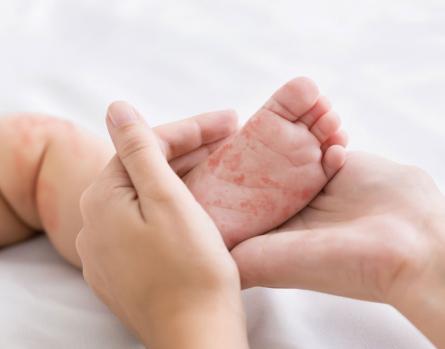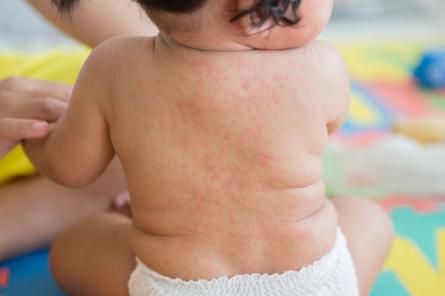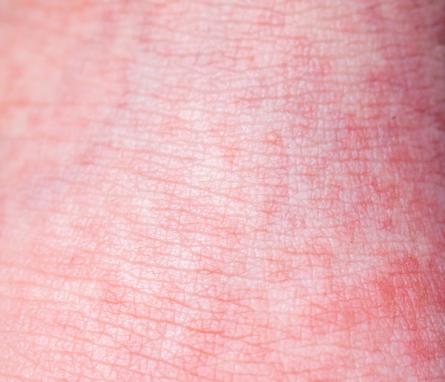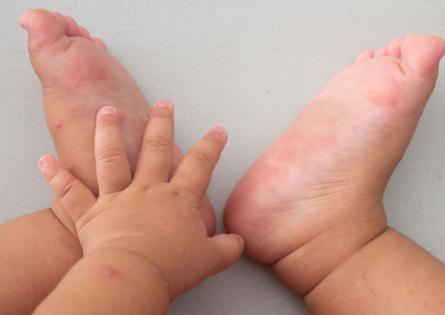- Conditions
- Childhood Skin Problems
- Viral Exanthem
Viral Exanthem
An exanthem is a rash on the skin, caused by the infection of certain types of viruses. Usually the rash presents alongside, or just after other symptoms, such as fever, sore throat, headache, fatigue, or aches and pains. These can be a reaction to toxins in the virus, or be the response of the body’s immune system.
Overview
A common viral exanthem is chickenpox, and in recent years, viruses that were previously less common – such as measles – have become increasingly common as parents have elected not to vaccinate their children.
Sometimes the cause of a viral exanthem is known, especially if they present in a distinctive way, or on a specific area of the body; but other times, a relatively common virus – such as a cold or flu - might cause a rash response in certain patients.
Exposure to viral exanthems might be relatively straightforward and resolve on their own, but they can cause serious complications, so it’s advisable to check in with the GP, or use telehealth services to help confirm a diagnosis, as the person who has the virus may need to be isolated to prevent spreading it to others.
Pregnant women, newborn babies and people who are immunocompromised or immunosuppressed as a result of health conditions or taking certain medications should especially be protected from exposure to viral exanthems.
Symptoms of Viral Exanthems
Depending on the virus, the symptoms – usually a blotchy red or pinkish rash that may have blisters that turn into lesions, and can be very itchy – may typically begin on, or appear only on one part of the body.
Different viruses often have additional symptoms that appear prior to a rash, or characteristics specific to that condition, which can help to determine the virus, as well as to indicate how long the child is infectious.

Measles - Usually preceded by fever, cough, very red eyes, and children with measles often look ill. The rash first appears on the face, then usually spreads to the chest and abdomen, followed by the arms and legs. Small spots with blueish-white centres can appear on the mucous membranes of the mouth 24-48 hours before the rash appears. The incubation period is 1-2 weeks and the child is contagious from the time they first develop symptoms until usually 4 days after the onset of the rash.

Rubella – Also known as the German Measles, the rash is preceded by a mild fever, conjunctivitis, upper respiratory issues, sore throat and swollen lymph nodes, and these symptoms can last up to 5 days. The pink or light red rash caused by rubella usually begins on the face and/or neck, and will then move to the chest and limbs. The patient is infectious from 1 week before, to 4 days after the appearance of the rash, and the incubation period is 2-3 weeks after exposure. For most people, rubella is a mild infectious disease, however exposure to the virus poses very serious risks for pregnant women and their foetuses.

Roseola – This condition typically affects infants under the age of 3, and the rash is preceded by a fever, abdominal pain, malaise and occasionally upper respiratory issues. The pink or light red macules (flat discoloured marks) and papules (bumps) will appear on the chest and the arms and neck, and will rarely appear on the face or the legs, and they tend to last 1-2 days. The infant is infectious during the entire period, and possibly before the onset of fever.

Scarlet fever – Usually affecting children 2-8 years of age, the rash is preceded by a mild fever, conjunctivitis, sore throat and headache, and may also cause nausea and vomiting. The child typically looks flushed and unwell, and a red rash with the texture of a fine sandpaper usually begins on the chest and stomach before spreading rapidly to other areas of the body. A white coating can appear on the tongue (strawberry tongue) and later peel off. As the rash fades, peeling skin occurs usually in the areas of the fingertips, toes and groin. The child is infectious for 5-7 days, and the incubation period is up to a week after exposure
These exanthems are characterised by the appearance of papules (acne-like bumps) and vesicles (cysts), for example, chickenpox.
Chickenpox - Usually affecting children under 10 years of age, but can occur at any age. The rash is often preceded by the symptoms of a common cold, which develop into a high fever. Pink or light red macules (flat discoloured marks) will appear on initially on the chest and before spreading to other areas of the body, becoming crops of itchy blisters that crust over. The rash can last 4-10 days, and the virus is highly contagious, affecting 90% of the people who come into contact with an infected person. The most infectious period of the disease is 1-2 days before the onset of the rash, but patients are usually infectious until all the lesions have crusted over – usually 5-7 days after the onset of the rash, and the incubation period is up to 3 weeks after exposure. While for most chidren, chickenpox is a mild infectious disease, exposure to the virus poses very serious risks for pregnant women and their foetuses, newborn babies, and for adults who are immunocompromised or immunosuppressed, either as a result of an underlying medical condition or due to medication.

Hand, foot and mouth disease - Usually affecting children under 10 years of age, the rash is preceded by a mild fever, listlessness, little to no appetite, abdominal pain and a sore mouth, and these symptoms can last up to 3 days. In the mouth, visible discoloured spots (macules) and bumps (papules) appear before developing into yellow-greyish ulcers, and the tongue may swell. This is usually sore and can make eating difficult, and the symptoms last in the mouth for 5-7 days. On the hands and feet, the rash usually appear shortly after the lesions in the mouth, and more commonly present on the hands than on the feet. These lesions, which may or may not be sore, crust over within 5-10 days and don’t normally leave scarring. The child is highly infectious until the lesions have resolved on their own, and the incubation period is 3-5 days after exposure.

Papular-purpuric gloves and socks syndrome – This rare illness more often affects teens, usually in the spring and summer, and can be associated with muscle and joint pain, swelling in the lymph nodes and fatigue. The virus causes symmetrical redness and swelling of the hands and feet, which later evolve into patches of rash that can either be flat discoloured brown or purpleish, and not turn white when pressed; pinpricks of red; or raised discoloured bumps on the skin. There is a clear demarcation line, meaning that the edge of the rash is highly visible, and it usually stops sharply at the wrists and ankles. Following the onset of the rash, it’s typical for the skin to peel, and the condition usually lasts 1-2 weeks. The incubation period is up to 10 days after exposure, but the condition is infectious for the duration of the rash, as the immune response usually occurs after the onset of the exanthem, rather than the rash being caused by the immune response. Exposure to the virus that causes the syndrome poses very serious risks for pregnant women and their foetuses, newborn babies, and for adults who are immunocompromised or immunosuppressed, either as a result of an underlying medical condition or due to medication.
Causes of Viral Exanthems
Viral exanthems are caused by contact with specific viruses, which occur either through direct contact with an individual who has it; or by coming into contact with contaminated items, such as toys, clothing or sports equipment contaminated with the virus. Many viruses are spread through droplets – for example coughs and sneezes – but they may spread in other ways, for example, skin to skin contact. Transmission may be different depending on the virus.
Treatment of Viral Exanthems at Derma
While your GP can diagnose and treat cases of viral exanthem, we are more than happy to see patients who prefer to consult a private dermatology specialist.
The appointment will begin with an examination of the skin (also called a skin check) and discussing your medical history. If you are seeking to confirm a diagnosis for a child, the dermatologist may ask questions about the medical histories of the parents, in order to rule out any underlying or co-occurring condition.
Most cases of viral exanthem self-resolve, with symptoms like pruritus or fever, usually managed using topical anti-itching or fever-reducing treatments available over the counter from chemists, but prescription creams or tablets might be necessary after the virus runs its course if there is an infection from scratching.
Together with the dermatologist, you will be able to discuss the latest and most effective treatments and explain all potential side-effects, enabling you to select the best option for you, or for your child.
Whatever your needs, you can rest assured that Derma will provide the very best care with access to the latest research and treatment methods.
Frequently Asked Questions
This is a rash that appears during or after a viral infection. They are usually, but not always associated with a fever and other systemic symptoms. They are very common in childhood.
The treatment of the specific exanthem will depend on the cause and the symptoms can be treated with moisturisers to reduce the itch and occasionally topical steroids to speed up resolution.
The rashes vary in how long they last and can be a few days to a few weeks in nature.
There are lots of different viruses that can cause an exanthem. Examples include chickenpox, measles, Piytriasis rosea, erythema infectiosum, papular acrodermatitis of childhood, Gianotti-Crosti Syndrome.
No, these rashes are not contagious although the virus that caused the rash may be, such as chickenpox if you haven’t previously been exposed.
These are usually widespread rashes that can look like any other rash and can be non specific. Some are flat and red, others are scaly and can be bumpy.
Send an Enquiry